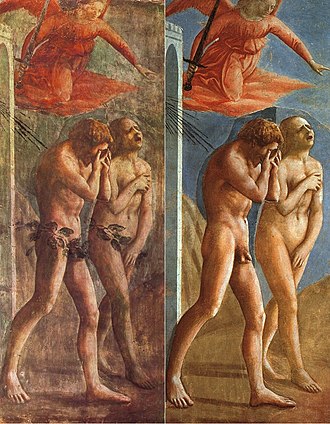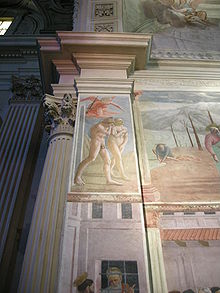The Expulsion From Paradise Masaccio

The Expulsion from the Garden of Eden, earlier and after restoration.
The Expulsion from the Garden of Eden (Italian: Cacciata dei progenitori dall'Eden ) is a fresco past the Italian Early Renaissance creative person Masaccio. The fresco is a single scene from the cycle painted around 1425 by Masaccio, Masolino and others on the walls of the Brancacci Chapel in the church of Santa Maria del Carmine in Florence. It depicts the expulsion of Adam and Eve from the garden of Eden, from the biblical Book of Genesis affiliate 3, albeit with a few differences from the canonical account.[ane]
Possible sources of inspiration [edit]
Many possible sources of inspiration take been pointed out that Masaccio may have drawn from. For Adam, possible references include numerous sculptures of Marsyas (from Greek Mythology) and a crucifix done by Donatello.
For Eve, art analysts usually point to different versions of Venus Pudica, such as Prudence by Giovanni Pisano.
Encompass up and restoration [edit]
| External video | |
|---|---|
 | |
| |

The scene in its context in the chapel.
3 centuries later the fresco was painted, Cosimo III de' Medici, in line with contemporary ideas of decorum, ordered that fig leaves be added to muffle the genitals of the figures. These were eventually removed in the 1980s when the painting was fully restored and cleaned.[i]
Influence on Michelangelo [edit]
Masaccio provided a large inspiration to the more than famous Renaissance painter Michelangelo, due to the fact that Michelangelo's teacher, Domenico Ghirlandaio, looked near exclusively to him for inspiration for his religious scenes. Ghirlandaio too imitated various designs done by Masaccio. This influence is most visible in Michelangelo's The Fall of Man and the Expulsion from the Garden of Eden on the ceiling of the Sistine Chapel.[ citation needed ]
Differences from Genesis [edit]
The main points in this painting that deviate from the account as it appears in Genesis:
- Adam and Eve are shown in the nude. Although this increases the drama of the scene, information technology differs from Genesis 3:21 (KJV) which states, "Unto Adam too and to his wife did the 50ORD God make coats of skins, and clothed them."
- Only i Cherub angel is present. Genesis 3:24 states, "So he drove out the man; and he placed at the east of the garden of Eden Cherubims, [...]" (-im existence the original Hebrew plural catastrophe of Cherub, doubled with an English plural in this version).
- The arch depicted at the garden archway does not appear in the Biblical account.
However, since artists often followed the studio tradition, painting from previous versions of a scene--and and then learning from and arresting other artists' expressive inventions into their own work--any responsible iconographic study would founder in the shallows of literal expectation if the painting were merely judged by its adherence to these details and therefore seen to exist successful simply if it functioned every bit a unproblematic illustration for the scene.
Masaccio'southward evocation of Eve's howling, deeply felt hurting in particular explores the significant of the expulsion on a previously unexamined, more personal level.
In 2nd Temple Jewish texts, however, Adam is described as glorious (Sirach 49, &c.), and in both some Rabbinic and Christian Patristic sources, there is a long tradition of reading the Hebrew word for "skin" as "light" (at that place is just one slight difference in the vowels between the two words), and taking the Genesis iii:21 words nigh God habiliment the pair in the Pluperfect sense, such as Sebastian Brock has shown is washed in the Syriac tradition. In Rabbinic sources there are several times when Adam is compared and contrasted with Moses, particularly in terms of Moses' luminosity after ascending the mount, and at to the lowest degree one text where Moses claims that his glory is greater than Adam's, because he did not lose his glory (Deuteronomy Rabbah 11:three); Genesis Rabbah xx:12 notes that Rabbi Meir had a scroll that had "light" instead of skin. The same tradition is found in Ephrem the Syrian, who, in his Hymns on Paradise vi, talks nigh Christ clothing the true-blue in the robe that Adam lost with the transgression. The Canon of St. Andrew of Crete has the cantor liken himself to Adam, and say "I accept plant myself stripped naked of God". Bede, in his commentary On Genesis, has similar comments: "having lost the glory of innocence by their transgression, they claimed for themselves the garment of an excuse". The "stripped of divinity/glory/innocence/laurels motif is thus found in the Latin, Greek, and Syriac traditions of the Church. It seems quite possible that these artists were working inside this very onetime tradition that stretches across traditions.
See also [edit]
![]()
- Fall of human being
References [edit]
- ^ a b c "Masaccio'southward Expulsion of Adam and Eve from Eden". Smarthistory at Khan Academy. Retrieved March xx, 2013.
The Expulsion From Paradise Masaccio,
Source: https://en.wikipedia.org/wiki/Expulsion_from_the_Garden_of_Eden
Posted by: jacksonhipild.blogspot.com


0 Response to "The Expulsion From Paradise Masaccio"
Post a Comment